“Gliding Slowly Back to the Body of Origin”
The interrelationship between body, voice, listening and the environment
Influences
The Writings of Susan Griffin
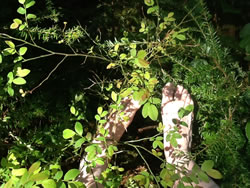
Back in the 1980s while studying composition at McGill University, one of my major compositions and early electroacoustic works was a piece entitled Rising Tides of Generations Lost, composed in 1984 using the Synclavier digital synthesizer, which at the time was a cutting edge tool of sound technology. The piece was inspired by my reading of Women and Nature: The roaring inside her by Susan Griffin. In the first sections of the book, she writes of how the ideas of patriarchal Western philosophy and religion evolved to establish and maintain power over women and nature. At various times in the text, italicized words would appear, representing the rising voice of women in the midst of various authoritative proclamations of how things are to be. The last section of the book presents an alternative vision of the connection between women, the body and nature. My composition Rising Tides was structured to embody this rising voice of the feminine and references aspects of European women’s history such as the witch burnings and the suffragettes, as well as my own ancestral connection with my mother and great aunt discussing memories of dreams and their earlier lives.
This secret life in us. The seen and the unseen. The speaking and the unspoken. The one who is what she ought to be and the one who is not. This other. The one from whom we are split away. Who follows us. Whose words lie under our tongues. Who speaks to us in our dreams. Sings in our blood and will not be still there. (Griffin 1978, 134–135)
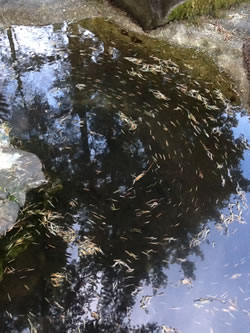
I returned to this quote a few years ago while preparing a text for my participation in The Myth And Theatre workshop run by Pantheatre, a company who has continued the vocal legacy of the Roy Hart Theatre in the south of France at the Roy Hart International Artistic Centre. I was particularly drawn to the phrase: “The one from whom we are split away. Who follows us.” I explored the text both vocally and through the choreographic theatre practices that Pantheatre has developed, with the intention of reconnecting with this one, this other self, who indeed has been following me, speaking to me in my dreams, and singing in my blood. No better place to do this than at the home of a vocal tradition that has been at the heart of my own journey to the voice and body since the early 1990s.
The unique characteristic of this vocal tradition is the connection made between voice, body and breath. In Susan Griffin’s 1992 book, A Chorus of Stones: The private life of war, she writes about Alfred Wolfsohn, the original founder of this vocal approach and the teacher of Roy Hart. As a soldier and stretcher-bearer in World War I, Wolfsohn sought to heal his war trauma through working with his voice (I’ll speak more about this approach to the voice below). In my own reading of Griffin’s Chorus of Stones, one’s relationship to the body was a major influential theme. I was particularly drawn to her idea of “gliding slowly”, as it appears in the following text:
This is often the way one moves into the future. For what you begin to see there is no ready language. If you were to remain silent, listen, perhaps in response you might be able to move in a new way. Glide into it slowly, aware of every slight difference, skin and cells intelligent, reading. (Griffin 1992, 230)
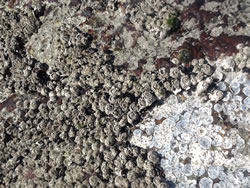
Prior to this quote, she had been speaking about the clouding of vision that occurred the year before World War I and how the assassination of Archduke Francis Ferdinand simply accelerated what had already begun. She says: “But those who are there at this moment have difficulty seeing into the future.” One could say that this is not unlike current positions around such issues as climate change, global warming and corporatization. She affirms that it is in the listening, and in the practice of moving slowly in tune with the body, that discoveries are made:
One comes upon a new body within the familiar body. And yet this new body, strange as it is, seems to be the rightful body, a body that opens up further and further to worlds one has dreamed or imagined might exist, a territory at once expansive and unknown and yet near, close as a lover, ready, willing. (Griffin 1992, 295)
Griffin expands further:
But this birth is not into a new body. It is into an older body, the body of origin, body of birth, the body before it has been socialized out of its own knowledge of itself. (Ibid., 297)
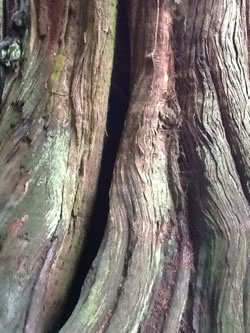
At the heart of the SOMO philosophical tradition one finds a split between mind and body, masculine and feminine, reason and intuition, and at its core, our cultural disconnect from nature itself. This split is at the root of the ecological crisis — we have so divorced ourselves from the natural world we see it only as a resource to be used for profitable gain. This other self from whom we are split away is actually our own body of birth, this body of origin. As Friedrich Nietzsche said in Thus Spoke Zarathustra: “There is more wisdom in your body than in your deepest philosophy.” Thus, the journey to the body of body became the central inquiry of my composition Gliding Slowly Back to the Body of Origin.
The Roy Hart Vocal Legacy
Central to my artistic process over many years has been a search for the voice, for as I see it, the voice — both physical as well as metaphorical — is, as Roy Hart put it, the “muscle of the soul.” The voice is our way of communication and being in the world, and is a holder of both our natural instincts and cultural imprints.
The signature part of Wolfsohn’s work was to open up the possibilities for the whole range of the human voice. Influenced by Carl Jung, Wolfsohn believed that when you expand your vocal range, you are expanding your entire psyche. Both his female and male students could sing in all the four ranges traditionally defined by gender: soprano, alto, tenor and bass. In a BBC documentary, one can hear a male singer singing the soprano aria from a Mozart opera, while a female singer sings a baritone aria. And not only lyric tones were part of the repertoire. Once Roy Hart brought in the use of spoken text to the practice when he formed a theatre company in the 1960s, the range and possibilities for the voice continued to expand to include a whole palette: motor, broken, stranded, breathy, nasal, and chorded sounds for example. Contemporary composers such as John Cage and Karlheinz Stockhausen were drawn to the theatre company’s studio to listen to what these vocal explorations were uncovering. One such composer was Peter Maxwell Davies. Following an intense period of collaboration between Hart and Davies, the classic work Eight Songs for a Mad King was born, with Hart performing the premiere in 1969. The piece demonstrates various aspects of Hart’s principle of the eight-octave voice, which he and his company were exploring through their creative research. 1[1. Visit the Roy Hart website for more information about the vocal work of the Roy Hart Theatre.]
A significant part of my own vocal journey began when I started working with Richard Armstrong, an original member of the Roy Hart company. My whole relationship to the voice shifted. During the early workshops I did with him, what I experienced was a full range of sounds created through connecting with the body and breath.
During my time working with Pantheatre at the Roy Hart Centre in 2013, I experienced the work of Enrique Pardo, co-founder of the theatre company along with Linda Wise, both former members of the Roy Hart Theatre company. One of the key components of the Pantheatre æsthetic is a particular way of working with texts : a form of juxtaposition that pits disparate texts and sonic elements together to create a new alchemical mix. Inspired by my work in choreographic theatre with Pardo, I have incorporated two different text sources into Gliding Slowly: one created from my own writings and the other excerpts from the journals of my great grandmother.
Deep Listening
During the summer of 2014, I attended NAISA’S software intensive that followed the Toronto International Electroacoustic Symposium. On the first day, composer Pauline Oliveros, who had been the visiting composer for Sound Travels and Keynote Lecturer at TIES 2[2. Pauline’s Keynote Lecture, “What Matters? Make the Music!,” was published in eContact 17.3 — TIES 2014.], led us in an experience of her piece entitled Extreme Slow Walk out on the lawn of the Wychwood Barns. Walking extremely slowly by moving consciously from the heel to toe areas of our feet, we were invited to enter into a place of Deep Listening (Pauline’s signature work) to not only the soundscape of the environment, but also to listen to and feel the earth frequency of 7.83 Hz vibrating through our feet, while sensing the pull of gravity on our bodies and the electromagnetic field of the earth.
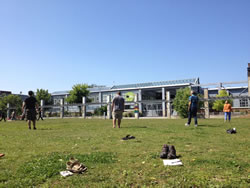
Although we were in a small urban park environment, my listening and body awareness expanded into a particular experience of being beyond time and space. The soundscape was alive, as my body gradually slowed down and attuned itself to the earth. Afterwards Pauline observed that the whole environment was responding to our group’s listening with the vibrant sounds of birds, people and animals, while the winds picked up and animated themselves through the swaying trees. I had experienced this piece of Oliveros’ several years earlier in the late 1970s at the original Music Gallery in Toronto during a concert she presented. At the time, I was somewhat puzzled that this activity constituted a “concert”, yet I left feeling like something in my awareness had gone through some sort of radical re-altering. It was a significant moment in my creative development.
Creative Process
The Sonic Oracle
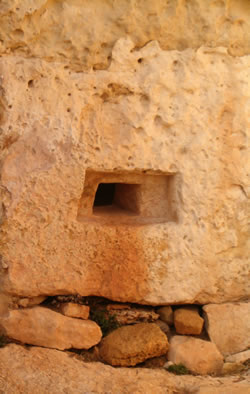
In 2004, I travelled to various ancient megalithic temple and cave sites in Greece and Malta. My goal was to create and record vocal improvisations at these places, and to build upon the body/breath connection to the voice. I extended this work to include a connection to the places themselves, to ancestral memory and to the earth. I explored the ancient sites through vocal improvisations that specifically worked with the power of sound frequencies to connect into the deeper layers of memory held within the stones and within the earth itself. I was searching for my own connection to the ancestral goddess traditions, to the ancient wisdom of the feminine that had long ago been exiled, and for a deeper knowing of how these ancient cultures lived in harmony with the natural rhythms of the earth. What evolved over time was a more interdisciplinary practice, where I consciously attuned myself to the architectural stone structures and the many female figurines, frescoes, painted or carved spiral patterns and fertility sculptures I encountered in the museums. I was inspired by the age-old tradition of the sibyls, seers and oracle priestesses from places such as Delphi, for example, who used a variety of ways and means to connect with the voice of the unseen world named as various gods and goddesses, and with the elements of nature.
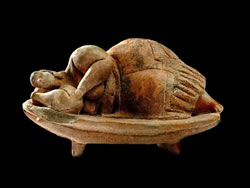
Working with the recordings, I created a series of pieces that were released on my CD, Sound Dreaming: Oracle Songs from Ancient Ritual Spaces. It was during the composition and editing of the CD that I realized I had been developing a specific approach that I am now calling “oracle singing”, or the sound oracle process. It is a way of using the voice to divine the sound stories that live in the land, in a particular place, or that are present in the natural environment. It opens up one way of connecting with mythical and archetypal consciousness, the legends and characters of specific cultures. It is a way of receiving wisdom from the earth and establishing a deep relationship with nature. A dialogue and a communion. Through the voice, we can connect with the deeper wisdom that dwells within us, and with the larger field of life.
“Gliding Slowly” as a Sound Oracle
In Gliding Slowly Back to the Body of Origin I further extended this sound oracle process by juxtaposing vocal and soundscape recordings made in natural environments and spoken word, along with live vocal improvisations that are altered in real time using sound processing plug-ins. The piece began to take shape during the 2014 intensive offered by NAISA. Immediately after experiencing the Extreme Slow Walk sonic meditation, I realized the connection between this way of walking and listening, and Susan Griffin’s words about “gliding slowly and listening to the body.” By bringing my sound oracle process into the mix, I was setting the stage for the beginning elements and the alchemical process at the heart of Gliding Slowly.
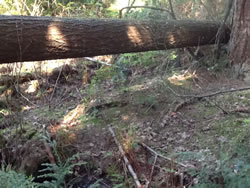
As mentioned earlier, my vision for the piece was the desire to uncover more about “this one from whom I am split away” and to reconnect with my own “body of origin”. So the next steps involved making extensive recordings of sonic oracle improvisations in various environments in Vancouver and also close to the Humber River in Toronto. I particularly tuned into the natural rhythms of the earth, sun and moon during equinox, solstice and new moon occurrences to make these recordings. The excerpt in Audio 1 demonstrates an original sonic oracle recording, followed by the processed version (starting at 1:12).
I also began to incorporate creative writing and painting after the recording process to further reflect on this journey into my own body of origin. These writings and images all helped to give shape to what I was discovering in the deeper layers of my own flesh, and these writings became the basis of one of the layers of spoken text in Gliding Slowly.
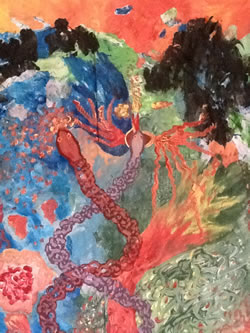
Two archetypes that emerged during this process were the ancient Sirens, long associated with the power of the feminine voice, and Lilith, the exiled original wife of Adam who is often portrayed in various art works as the tempting serpent and symbolizes the exiled feminine in the collective unconscious.
The other layer is a series of excerpts from my own great grandmother’s daily journals, written during 1928–29 and documenting her everyday life on the family farm near Tillsonburg, Ontario. The chosen timeframe just happens to include the documentation of the birth of my own mother. These entries at first seem to communicate a simple life, but in digging below the surface, I found a woman supportive of the creative process, deeply attuned to the rhythms of the land and to the weather, and interested in new technologies such as the radio. However, amidst the chronicling of daily life household tasks, there is the noticeable absence of any emotion. “Do not speak of your discontent” was a phrase that sprung out of me as a response to several hours of reading and editing the texts. I also became aware of her cultural place as a woman at a time when women had just received the right to vote in Canada ten years earlier. The early beginnings of the return of the feminine archetypes from their “exiled” position.
“Gliding Slowly” as a Constructed Space
I have conceived of Gliding Slowly as a constructed space in which I as a performer can enter into the sonic oracle process performing live, improvised vocalizations within a performance environment, as guided by the surrounding pre-composed sound worlds and spoken texts. During the NAISA intensive in summer 2014, I began by working with a sensor that would use my walking movements to create the signal processing. During work on this composition, I decided to use the SOMO controller, designed by Loretta Faveri in collaboration with dancer Denise Mireau. Since 2011 they have been working together to develop ways of working with body movement to generate sound progressions, in the context of Loretta’s OCADU project, Beyond Cage and Cunningham. For the performance of Gliding Slowly I began working collaboratively with creative coder Ian Jarvis, who expanded the standard SOMO Max/MSP patch. By wearing the controller on my wrist, the patch enabled me to process both my live voice and the pre-composed sound files through my wrist movements. Other movements in the piece that expanded the idea of “gliding slowly” in the live performance were performed by Ruth Danziger, who also narrated the texts.
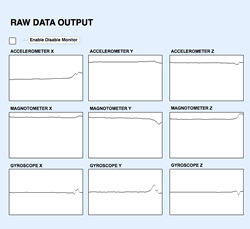
Essentially the score for the piece is the unique configuration of the patch and the timeline progression of sonic events. I also used the patch to process the recorded sound files that are primarily vocal recordings or sonic oracles made in natural environments, including the forests of Stanley Park in Vancouver and a forested area of mounds believed to be part of the early Seneca village Teiaiagon, located along the Humber River. Another example of the SOMO controller processing sound, with the addition of soundscape recordings, is found in Audio 2.
The big challenge in the creation of this work was — and continues to be — in discerning the meaning and practice of the metaphor of an “alchemical mixing” of elements as the guiding force for the creative process. On the one hand, it could be said that any work of art is a mixture of components, whether conscious or not. However, bringing disparate elements together as separate entities or layers in themselves and hoping that it all creates a coherent whole is another thing altogether. It was only a day before the performance that everything started to gel together, which felt like a huge risk. It leads me to reflect on the nature of the creative process and the source of the impulses and intuitive guidance that were such crucial ingredients. In this more layered approach, there is also the question around the non-musical elements — the creative writing, walking and listening in nature, and painting — and how these components influenced the compositional choices, which came much later in the process.
Looking at the broader macro level, it’s important to recognize the huge force of exploring genre bending within current musical practice. Perhaps this exploration of mine is part of that force, yet of a different sort, extending outside of an engagement with other musical genres and entering more into the realm of dream, myth and archetypal consciousness in parallel to, or even in juxtaposition with current technologies and interactive practices. Finally, coming back to the body, the source of the initial inspiration. The body — a complex organism that is the container or cauldron for all these ingredients. A Body of Origin in process.
Bibliography
Griffin, Susan. Women and Nature: The roaring inside her. San Francisco: Harper & Row, 1978.
_____. A Chorus of Stones: The private life of war. New York: Double Day, 1992.
Social top